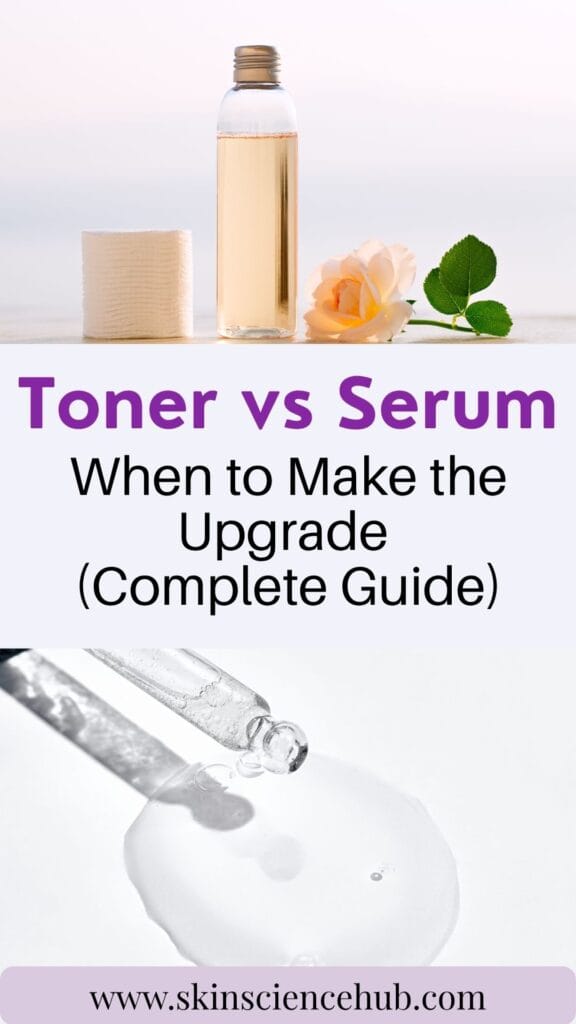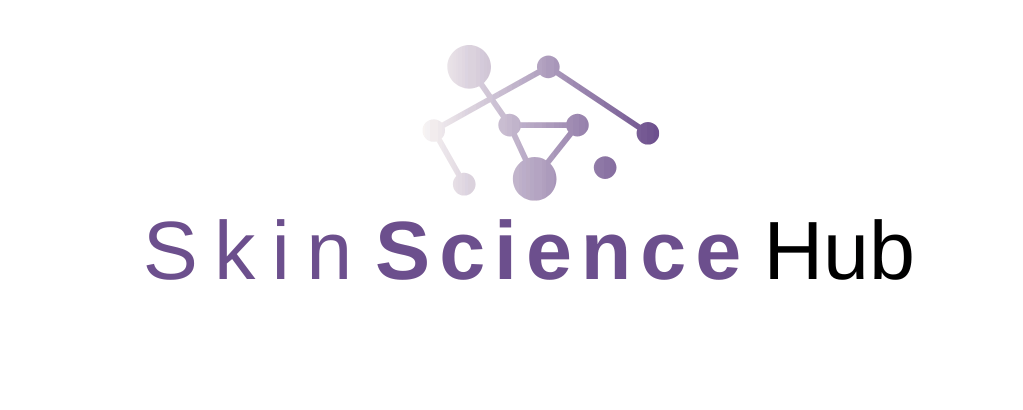When to Upgrade from Toners to Exfoliating Serums
You’ve been using an exfoliating toner consistently for months. Your skin looks better than before, but progress has stalled. The texture improvements plateaued weeks ago, and those stubborn dark spots aren’t fading as fast as you hoped.
Most people at this stage make one of two mistakes: they either keep using the same gentle toner hoping for different results, or they jump straight to harsh peels without building tolerance. Both waste time and potentially damage your skin.
Upgrading to exfoliating serums at the right time pushes past the plateau toners hit. Serums use higher acid concentrations (5-20%) that deliver stronger results without the extreme irritation peels cause, but only if you’re actually ready for them.
Here’s how to know when to make the upgrade and what changes when you do.

Exfoliating Serums vs Toners: 4 Key Differences
| Feature | Toners | Serums |
|---|---|---|
| Concentration | 0.5-2% acids | 5-20% acids |
| Frequency | Daily | 2-3x weekly |
| Texture | Watery | Thick, viscous |
| Purpose | Maintain | Correct |
1. Concentration: Serums Contain 5-20% Acids vs Toners at 0.5-2%
Concentration is everything. Toners contain 0.5-2% acids designed for daily use, while serums pack 5-20% acids meant for 2-3 times weekly application, which makes them 3-10 times stronger than toners.
A 10% glycolic serum isn’t just a slightly better version of a 2% toner. It’s fundamentally different because the higher concentration penetrates deeper and works faster, but it also means your skin needs recovery time between applications. If you’ve been using a 2% toner for months and progress has stalled, you’ve hit the concentration ceiling, and that toner can’t deliver 10% serum results no matter how consistently you use it.
2. Texture: Watery Toners vs Thick Serums
Toners are watery and spread easily across your entire face, while serums are thicker and more viscous, so you only need 3-4 drops instead of a cotton pad soaked with toner. This isn’t just about texture, though. The thicker formula sits on your skin longer and delivers concentrated actives more efficiently, whereas toners evaporate quickly or get absorbed into cotton pads before they can work as effectively.
3. How Often to Use: Daily Toners vs 2-3x Weekly Serums
Daily toner use builds results gradually over months because the low concentration is gentle enough for everyday application. Serums work faster but demand recovery time since your skin can’t process 10% glycolic acid daily the way it handles 2% glycolic acid. If you tried using a 10% serum every day, you’d see redness, flaking, and barrier damage within a week because higher concentration requires lower frequency.
Usage guide:
- Toners (0.5-2%): 5-7 times weekly
- Serums (5-10%): 2-3 times weekly
- Strong serums (10-20%): 2 times weekly maximum
Space serum applications at least 48 hours apart to give your skin time to complete its natural cell turnover cycle.
4. Purpose: Toners Maintain, Serums Correct
Toners maintain results and prepare skin for other products, which makes them excellent for prevention once you’ve achieved your goals. Serums actively treat concerns toners couldn’t fully address, like stubborn texture, deeper hyperpigmentation, and congested pores that won’t clear with gentle exfoliation.
Think of it this way: toners are prevention, serums are correction. This is why upgrading to serums makes sense when your toner results plateau after 12+ weeks of consistent use.
Common Questions About Upgrading
Can You Use Serum Without Toner?
Yes, serums work independently and don’t require toner to be effective. If your toner results have plateaued, you can replace it with a serum and just adjust frequency to 2-3x weekly instead of daily.
Do You Need Both Toner and Serum?
No, using both an exfoliating toner and an exfoliating serum is over-exfoliation, so choose one based on where you are in your skincare journey. The exception is using a hydrating toner (no acids) alongside an exfoliating serum, which works fine since you’re not doubling up on exfoliation.
For a complete breakdown of toner types, see our exfoliating toner guide.
When to Upgrade: Are You Ready for Exfoliating Serums?
Not everyone needs serums, and moving to higher concentrations before your skin is ready causes irritation without better results. The key is building a strong foundation with toners first, then upgrading when you’ve truly maxed out what gentler concentrations can do.
3 Signs You’re Ready for Exfoliating Serums
Sign 1: You’ve built solid tolerance with toners
You’ve been using exfoliating toners consistently for at least 3 months without any irritation, and your skin comfortably tolerates 2% acids 5-7 times weekly without tightness, redness, or flaking. This is the tolerance test, and it’s crucial because if you can’t handle a 2% toner daily, you definitely can’t handle a 10% serum twice weekly.
Sign 2: Your progress has genuinely plateaued
Results have stalled for 12+ weeks despite consistent use. If you’re still seeing steady improvement with your toner, stick with it because you haven’t reached the concentration ceiling yet. But if your skin looks exactly the same as it did 3 months ago, you’ve likely maxed out what that concentration can achieve.
Sign 3: You still have concerns toners can’t touch
Stubborn texture, persistent dark spots, or deeper lines remain despite months of consistent toner use. These concerns need stronger concentrations to improve, which is exactly what serums provide. If your toner cleared your main concerns, you don’t need to upgrade.
When to Wait: Stick with Toners Longer
You’re too new to acids
If you’re new to chemical exfoliation or have been using acids for less than 3 months, your skin needs time to build tolerance gradually. Even if you’re eager for faster results, jumping to serums too early just causes irritation without the benefits you’re hoping for.
Your toner is still working
If your skin still shows improvement with your current toner, there’s no reason to increase concentration when the gentler option is working. When in doubt, give your toner another month and reassess.
You’re experiencing irritation
Any current irritation, redness, or sensitivity with your toner means your skin is already at its limit. If you have active eczema, rosacea flares, or a compromised skin barrier, address those issues first before considering stronger acids.
You’re using prescription retinoids
Don’t add exfoliating serums without your dermatologist’s approval if you’re using prescription retinoids, since combining these can cause severe irritation even if your skin handled toners fine.
Choosing Your Acid Type: AHA vs BHA
Now that you know you’re ready, your next decision is which acid family matches your concerns: AHA or BHA. This choice matters because they work in fundamentally different ways.

AHA Serums (Glycolic, Lactic, Mandelic)
AHA serums work on your skin’s surface to address dullness, texture, and hyperpigmentation. They increase cell turnover on the surface layer, which reveals fresher skin underneath and fades dark spots over time.
Start with AHA serums if your main concerns are:
- Dull, lackluster skin that needs brightening
- Rough or uneven texture you can feel when you touch your face
- Fine lines and early signs of aging around eyes and mouth
- Dark spots from old acne or sun damage
- Overall sun damage that makes skin look tired
AHAs come in three main types (glycolic, lactic, and mandelic), and each delivers different speeds and intensity levels. Glycolic acid works fastest but irritates easiest, lactic acid balances effectiveness with gentleness, and mandelic acid is the most gentle option for sensitive or reactive skin. Most beginners should start with lactic acid at 5% because it gives you strong results without overwhelming your skin.
Critical requirement: AHAs increase sun sensitivity for up to 7 days after each application, so you must use SPF 50+ every morning when using any AHA serum, even on days you don’t apply it. Skip the sunscreen and you risk undoing all your progress with new sun damage and hyperpigmentation.
BHA Serums (Salicylic Acid)
BHA serums work differently than AHAs because they’re oil-soluble, which means they penetrate into your pores to dissolve oil and debris from inside rather than just working on the surface. This makes them uniquely effective for pore-related concerns.
Start with BHA serums if your main concerns are:
- Clogged pores that look like tiny bumps under your skin
- Blackheads concentrated in your T-zone
- Whiteheads that keep appearing in the same spots
- Oily skin that feels greasy by midday
- Mild to moderate acne with inflamed pimples
Most BHA serums contain 2% salicylic acid, which is the standard concentration that balances effectiveness with safety. You won’t see many options above 2% because salicylic acid’s oil-soluble nature makes even 2% quite strong when formulated correctly as a serum.
The advantage: Unlike AHAs, BHAs don’t significantly increase sun sensitivity, which makes them easier to incorporate if you’re nervous about photosensitivity or spend a lot of time outdoors. You still need daily sunscreen (everyone does), but you won’t get the dramatic photosensitivity that AHA serums cause.
Can’t decide between AHA and BHA? Start with AHA if you have multiple surface concerns (texture, dullness, spots). Start with BHA if clogged pores are your main frustration. After 2-3 months of successful use, you can add the other acid type on alternate days if needed.
Quick Start Guide: Your First Month with Serums
Ready to make the upgrade? Here’s exactly how to start safely and build tolerance without triggering irritation.
Week 1-4: Building Tolerance
Step 1: Choose your product carefully
Pick one acid type (AHA or BHA) based on your primary concern from the section above, and don’t use both when starting. Choose the lowest available concentration you can find, even if you used 2% toners successfully for months. For AHAs, look for 5% formulas. For BHA, use 2% (which is standard).
The format change from toner to serum matters as much as the concentration, so treat this as starting fresh even though you have toner experience.
Step 2: Application technique matters
Apply to completely dry skin after cleansing, because water dilutes acids and reduces effectiveness. If your skin still feels damp, wait 3-5 minutes until it’s bone dry. Use 3-4 drops total for your entire face, spreading evenly while avoiding the eye area and lips. Don’t apply extra product to problem areas thinking it’ll work faster, it won’t, and you’ll just irritate that spot.
Wait 2-3 minutes before applying other products so the acid has time to work at the right pH. Then follow with your regular moisturizer. Never skip moisturizer after using exfoliating serums, even if you have oily skin, because the acids are drying and your barrier needs support.
Step 3: Frequency and timing
Use twice weekly for the entire first month, spacing applications 2-3 days apart. Monday and Thursday evenings work well because they’re spaced 3 days apart. Use AHA serums only at night because of sun sensitivity, and apply SPF 50+ every morning. Use BHA serums morning or night as you prefer, though most people find nighttime easier for building a consistent routine.
What’s normal vs. what’s concerning
Normal reactions during the first month include mild tingling that fades within 30 seconds, temporary warmth on your skin, and slight redness that disappears within an hour. Light flaking is also normal as the first layer of dead cells sheds, especially in week 2-3.
Stop immediately if you experience burning that lasts more than a minute, persistent redness that doesn’t fade after an hour, increased breakouts in areas where you don’t normally break out, or tight, stinging sensations when you apply other products. These signal irritation, not normal adjustment, and mean you need to drop back to your previous toner for 2-4 weeks before trying a gentler serum formula.
After Month 1: Adjusting Up
If you’ve had zero irritation for 4 weeks and your skin looks and feels good, you can increase to 3x weekly in month two. Space applications evenly (Monday, Wednesday, Friday works well). Most people stay at 3x weekly long-term because it delivers excellent results without pushing into irritation territory.
Only consider increasing concentration (from 5% to 10% AHA) after 8-12 weeks at your current strength if results have plateaued and your skin shows no sensitivity at all during or after application.
What to Expect: Your Upgrade Results Timeline
Serums work faster than toners because of higher concentrations, but they still require patience and consistent use over weeks. Here’s what changes and when.
Weeks 1-2: Adjustment Period
Your skin will feel noticeably smoother to touch within the first week, though visible changes in the mirror haven’t appeared yet. This tactile smoothness is the first sign the serum is working, even before you can see improvements. Light flaking might occur as the first layer of built-up dead cells releases, which is normal and temporary, not a sign of over-exfoliation.
If you’re using BHA for clogged pores, this is when purging might start, which brings existing clogs to the surface faster in areas where you normally break out. Purging looks worse temporarily but means the serum is working to clear your pores from inside. This should resolve within 4-6 weeks.
Weeks 3-4: First Visible Changes
Look at your skin in direct natural light and you’ll see texture improvements that weren’t visible before. Your skin looks smoother and more refined, almost like you’ve applied a subtle filter. Pores appear smaller because they’re less congested, and if you’re using BHA specifically, blackheads start clearing from your nose and chin.
If you’re using AHA, dullness lifts and your skin looks brighter and fresher, like you got more sleep. Dark spots might look slightly lighter, though complete fading takes longer. This is when most people feel confident the upgrade was worth it because the improvements are undeniable.
Weeks 6-8: Proving Ground
This is where serums prove their worth over toners, since concerns that plateaued with gentler products start improving again. Texture becomes noticeably smoother when you run your fingers across your face, tone evens out so you need less concealer, and fine lines look softer. Dark spots continue fading but aren’t gone yet (hyperpigmentation takes 8-12 weeks minimum to fade significantly).
Troubleshooting if you’re not seeing results: If you haven’t seen meaningful improvement by week 8, the issue is either that the acid type doesn’t match your concern (try switching from AHA to BHA or vice versa), or the concentration might be too low for your tolerance level (consider moving from 5% to 10% AHA if your skin shows zero sensitivity).
Weeks 10-12: Full Results Assessment
Maximum benefits from your current concentration appear around 12 weeks of consistent use, which is when you should honestly assess whether you’re satisfied with results or want to adjust your routine. Most people maintain at this level rather than pushing to higher concentrations because the results satisfy them, and higher concentrations increase irritation risk without dramatically better outcomes.
What serums fix well: Surface texture you can feel with your fingers, recent hyperpigmentation (less than 1 year old), clogged pores and blackheads, mild acne with occasional breakouts, fine lines that are just starting to form, and overall dullness.
What serums can’t fix: Deep acne scars that create visible indentations, significant sun damage accumulated over years, deep wrinkles around eyes and mouth, or loose skin that’s lost elasticity. These concerns need professional treatments like laser resurfacing, microneedling, or prescription retinoids because the damage extends deeper than serums can reach.
The Bottom Line
Exfoliating serums work when toners stop delivering results, but only if you’re ready. Build tolerance with toners for 3+ months first, start with the lowest concentration (5% AHA or 2% BHA), and use 2-3 times weekly. The non-negotiables: daily SPF 50+ with AHA serums, spacing applications 48 hours apart, and giving them 10-12 weeks before deciding if they’re working.
Most people maintain at 3x weekly long-term because that delivers results without irritation. Slow and steady wins here.





